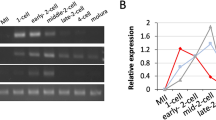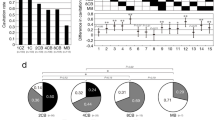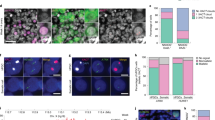Abstract
How maternal factors in oocytes trigger zygotic genome activation (ZGA) is a long-standing question in developmental biology. Recent studies in 2-cell-like embryonic stem cells (2C-like cells) suggest that transcription factors of the DUX family are key regulators of ZGA in placental mammals1,2. To characterize the role of DUX in ZGA, we generated Dux cluster knockout (KO) mouse lines. Unexpectedly, we found that both Dux zygotic KO (Z-KO) and maternal and zygotic KO (MZ-KO) embryos can survive to adulthood despite showing reduced developmental potential. Furthermore, transcriptome profiling of the MZ-KO embryos revealed that loss of DUX has minimal effects on ZGA and most DUX targets in 2C-like cells are normally activated in MZ-KO embryos. Thus, contrary to the key function of DUX in inducing 2C-like cells, our data indicate that DUX has only a minor role in ZGA and that loss of DUX is compatible with mouse development.
This is a preview of subscription content, access via your institution
Access options
Access Nature and 54 other Nature Portfolio journals
Get Nature+, our best-value online-access subscription
$29.99 / 30 days
cancel any time
Subscribe to this journal
Receive 12 print issues and online access
$209.00 per year
only $17.42 per issue
Buy this article
- Purchase on Springer Link
- Instant access to full article PDF
Prices may be subject to local taxes which are calculated during checkout



Similar content being viewed by others
Data availability
All RNA-seq data sets that were generated in this study have been deposited in the Gene Expression Omnibus under accession number GSE121746. Oocyte and 1-cell RNA-seq data were obtained from a previous publication23. HA-DUX ChIP–seq data and Dux overexpression RNA-seq data in mouse ES cells were downloaded from a previous report1.
References
Hendrickson, P. G. et al. Conserved roles of mouse DUX and human DUX4 in activating cleavage-stage genes and MERVL/HERVL retrotransposons. Nat. Genet. 49, 925–934 (2017).
De Iaco, A. et al. DUX-family transcription factors regulate zygotic genome activation in placental mammals. Nat. Genet. 49, 941–945 (2017).
Hamatani, T., Carter, M. G., Sharov, A. A. & Ko, M. S. Dynamics of global gene expression changes during mouse preimplantation development. Dev. Cell 6, 117–131 (2004).
Wang, Q. T. et al. A genome-wide study of gene activity reveals developmental signaling pathways in the preimplantation mouse embryo. Dev. Cell 6, 133–144 (2004).
Zeng, F., Baldwin, D. A. & Schultz, R. M. Transcript profiling during preimplantation mouse development. Dev. Biol. 272, 483–496 (2004).
Svoboda, P. et al. RNAi and expression of retrotransposons MuERV-L and IAP in preimplantation mouse embryos. Dev. Biol. 269, 276–285 (2004).
Macfarlan, T. S. et al. Embryonic stem cell potency fluctuates with endogenous retrovirus activity. Nature 487, 57–63 (2012).
Zalzman, M. et al. Zscan4 regulates telomere elongation and genomic stability in ES cells. Nature 464, 858–863 (2010).
Lu, F. & Zhang, Y. Cell totipotency: molecular features, induction, and maintenance. Natl Sci. Rev. 2, 217–225 (2015).
Percharde, M. et al. A LINE1-nucleolin partnership regulates early development and ESC identity. Cell 174, 391–405 e19 (2018).
Ishiuchi, T. et al. Early embryonic-like cells are induced by downregulating replication-dependent chromatin assembly. Nat. Struct. Mol. Biol. 22, 662–671 (2015).
Rodriguez-Terrones, D. et al. A molecular roadmap for the emergence of early-embryonic-like cells in culture. Nat. Genet. 50, 106–119 (2018).
Eckersley-Maslin, M. A. et al. MERVL/Zscan4 network activation results in transient genome-wide DNA demethylation of mESCs. Cell Rep. 17, 179–192 (2016).
Snider, L. et al. Facioscapulohumeral dystrophy: incomplete suppression of a retrotransposed gene. PLoS Genet. 6, e1001181 (2010).
Geng, L. N. et al. DUX4 activates germline genes, retroelements, and immune mediators: implications for facioscapulohumeral dystrophy. Dev. Cell 22, 38–51 (2012).
Whiddon, J. L., Langford, A. T., Wong, C. J., Zhong, J. W. & Tapscott, S. J. Conservation and innovation in the DUX4-family gene network. Nat. Genet. 49, 935–940 (2017).
Clapp, J. et al. Evolutionary conservation of a coding function for D4Z4, the tandem DNA repeat mutated in facioscapulohumeral muscular dystrophy. Am. J. Hum. Genet. 81, 264–279 (2007).
Fujii, W., Kawasaki, K., Sugiura, K. & Naito, K. Efficient generation of large-scale genome-modified mice using gRNA and CAS9 endonuclease. Nucleic Acids Res. 41, e187 (2013).
Han, J. et al. Efficient in vivo deletion of a large imprinted lncRNA by CRISPR/Cas9. RNA Biol. 11, 829–835 (2014).
Inoue, K. et al. The rodent-specific microRNA cluster within the Sfmbt2 gene is imprinted and essential for placental development. Cell Rep. 19, 949–956 (2017).
Wang, L. et al. Large genomic fragment deletion and functional gene cassette knock-in via Cas9 protein mediated genome editing in one-cell rodent embryos. Sci. Rep. 5, 17517 (2015).
Zhang, L. et al. Large genomic fragment deletions and insertions in mouse using CRISPR/Cas9. PLoS ONE 10, e0120396 (2015).
Wu, J. et al. The landscape of accessible chromatin in mammalian preimplantation embryos. Nature 534, 652–657 (2016).
Wang, H. et al. One-step generation of mice carrying mutations in multiple genes by CRISPR/Cas-mediated genome engineering. Cell 153, 910–918 (2013).
Inoue, A., Chen, Z., Yin, Q. & Zhang, Y. Maternal Eed knockout causes loss of H3K27me3 imprinting and random X inactivation in the extraembryonic cells. Genes Dev. 32, 1525–1536 (2018).
Kim, D., Langmead, B. & Salzberg, S. L. HISAT: a fast spliced aligner with low memory requirements. Nat. Methods 12, 357–360 (2015).
Trapnell, C. et al. Transcript assembly and quantification by RNA-seq reveals unannotated transcripts and isoform switching during cell differentiation. Nat. Biotechnol. 28, 511–515 (2010).
Jin, Y., Tam, O. H., Paniagua, E. & Hammell, M. TEtranscripts: a package for including transposable elements in differential expression analysis of RNA-seq datasets. Bioinformatics 31, 3593–3599 (2015).
Anders, S. & Huber, W. Differential expression analysis for sequence count data. Genome Biol. 11, R106 (2010).
Ramirez, F., Dundar, F., Diehl, S., Gruning, B. A. & Manke, T. deepTools: a flexible platform for exploring deep-sequencing data. Nucleic Acids Res. 42, W187–W191 (2014).
Robinson, J. T. et al. Integrative genomics viewer. Nat. Biotechnol. 29, 24–26 (2011).
Acknowledgements
We would like to thank A. Inoue for training Z.C. to manipulate mouse embryos and for advice on generating the Dux KO mouse lines. We acknowledge X. Fu, C. Zhang, X. Wu and W. Zhang for helpful discussion. We thank N. Djekidel for his advice on bioinformatic analyses. This project was supported by the US National Institutes of Health (NIH) (R01HD092465) and Howard Hughes Medical Institute. Y.Z. is an Investigator of the Howard Hughes Medical Institute.
Author information
Authors and Affiliations
Contributions
Z.C. and Y.Z. conceived the project. Z.C. designed and performed experiments. Z.C. analyzed sequencing datasets. Z.C. and Y.Z. interpreted the data and wrote the manuscript.
Corresponding author
Ethics declarations
Competing interests
The authors declare no competing financial interests.
Additional information
Publisher’s note: Springer Nature remains neutral with regard to jurisdictional claims in published maps and institutional affiliations.
Integrated supplementary information
Supplementary Figure 1 Dux zygotic CRISPR-Cas9 injection does not impair mouse pre-implantation development.
a) Schematic view of the genotyping primer design (not drawn in scale). b) Blastocyst rate of embryos following Cas9/sgRNA injection at 1-cell stage. The concentration of Cas9, and sgRNA1/2 are 100, 50, 50 ng/µl, respectively. Numbers in the parentheses are the embryos analyzed for each group. Two independent zygotic CRIPSR-Cas9 injections were performed. BDF1 strain was used for this experiment. c) An agarose gel image illustrating the nested PCR-based genotyping assay of the F0 blastocysts. Genotyping results of 13 embryos are shown in this image. Black and red arrows point to the embryos with mono-allelic and bi-allelic deletion of the Dux cluster, respectively. A full scan of the gel can be found in Supplementary Figure 6. d) Summary of the Dux cluster genotyping results of F0 blastocysts (n = 36).
Supplementary Figure 2 Generation of Dux F0 mice and summary of the genotyping results.
a) Summary of CRISPR/Cas9-mediated Dux cluster KO in mice. b) An agarose gel illustrating the genotyping assay used for Dux mouse colonies. A full scan of the gel can be found in Supplementary Figure 6. c) Summary of the Dux mice crosses. Litter size is presented as mean ± SD.
Supplementary Figure 3 Loss of DUX does not impair ovulation and pre-implantation development.
a) Number of ovulated oocytes and 1-cell embryos (IVF) collected from WT/Het and KO female mice. Each grey dot represents a single female mouse analyzed (n = 9 for each group). Female mice for both groups were subject to superovulation. For 1-cell embryos, oocytes from WT/Het and KO females were fertilized with WT and KO sperm, respectively. Measure of center and error bar indicate mean and SD, respectively. Two-tailed student’s t-test was used to compare the numbers of oocytes and 1-cell embryos between Het/WT and KO groups (oocyte p = 0.97; 1-cell p = 0.85). b) Percentage of IVF-derived embryos that reached the 2-cell (~ 28 hpi), 4-cell (~ 48 hpi), morula (~ 78 hpi), and blastocyst (~ 120 hpi) stages. The IVF experiments were performed four times (denoted as dots) and in total 235 (from 13 mice) and 223 (from 11 mice) embryos were analyzed for control and KO group, respectively. Measure of center and error bar indicate mean and SD, respectively. Fisher’s exact test (two-sided) was used to compare blastocyst stage embryos between the two groups (p = 0.45). c) Representative images of WT/Het and MZ-KO embryos at ~ 120 hpi. The IVF experiments were performed four times. Scale bar, 100 μm.
Supplementary Figure 4 Scatter plots showing high reproducibility of the RNA-seq replicates.
Pearson correlation was indicated for each pair of replicates. Two and three RNA-seq replicates were performed for one-cell and two-cell embryos, respectively.
Supplementary Figure 5 The expression levels of the majority of known DUX targets were not affected by Dux MZ-KO in 2-cell embryos.
a) Scatter plot comparing the gene expression levels between 2C-like (MERVL::GFP-positive) and non-2C cells (MERVL::GFP-negative). Two RNA-seq replicates (Hendrickson P.G. et al., Nat Genet. 49, 941–945, 2017) were used for differential gene expression analyses. Genes expressed higher in 2C-like cells and higher in non-2C cells are colored with red and blue, respectively (FC > 2 and FDR < 0.05). b) Genome browser views illustrating the expression levels of known DUX targets in 2C-like cells and 2-cell embryos. HA-DUX ChIP-seq track and RNA-seq tracks of non-2C (2C-) and 2C-like (2C+) cells were obtained from a previous study (Hendrickson P.G. et al., Nat Genet. 49, 941–945, 2017). Only uniquely aligned reads were used to generate the ChIP-seq and RNA-seq tracks.
Supplementary Figure 6 Full scans of gel images presented in Supplementary Figures 1 and 2.
Black boxes indicate the cropped areas.
Supplementary information
Rights and permissions
About this article
Cite this article
Chen, Z., Zhang, Y. Loss of DUX causes minor defects in zygotic genome activation and is compatible with mouse development. Nat Genet 51, 947–951 (2019). https://doi.org/10.1038/s41588-019-0418-7
Received:
Accepted:
Published:
Issue Date:
DOI: https://doi.org/10.1038/s41588-019-0418-7
This article is cited by
-
The homeobox transcription factor DUXBL controls exit from totipotency
Nature Genetics (2024)
-
Maternal TDP-43 interacts with RNA Pol II and regulates zygotic genome activation
Nature Communications (2023)
-
Sleeping embryonic genomes are awoken by OBOX proteins
Nature (2023)
-
OBOX regulates mouse zygotic genome activation and early development
Nature (2023)
-
Selective binding of retrotransposons by ZFP352 facilitates the timely dissolution of totipotency network
Nature Communications (2023)



